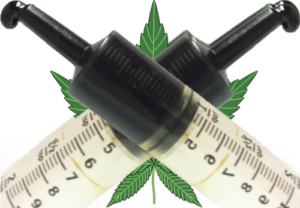Researchers looking for risk factors of heart disease tested the lung function of 5,115 young adults over the course of 20 years. Tobacco smokers lost lung function over time, but pot users actually showed an increase in lung capacity.
It’s possible that the increased lung capacity may be due to taking a deep breaths while inhaling the drug and not from a therapeutic chemical in the drug.
The smokers in that study only toked up a few times a month, but a more recent survey of people who smoked pot daily for up to 20 years found no evidence that smoking pot harmed their lungs, either.
“Already, many doctors and researchers believe that marijuana has incredibly powerful neuroprotective properties, an understanding based on both laboratory and clinical data,” Grinspoon wrote.
Goodell said he’d consider permitting athletes to use marijuana if medical research shows that it’s an effective neuroprotective agent.
At least one recent study on the topic found that patients who had used marijuana were less likely to die from traumatic brain injuries.
The National Academies report said there are good studies showing marijuana users are not more likely to have cancers associated with smoking say Orlando Marijuana Doctors.
This is a complicated one, because it involves effects that can be both positive and negative. Marijuana disturbs sleep cycles by interrupting the later stages of REM sleep. In the long run, this could be a problem for frequent users.
Even the NIH’s National Institute on Drug Abuse lists medical uses for cannabis.
At least 84% of the public believes the drug should be legal for medical uses, and recreational pot usage is less controversial than ever, with at least 61% of Americans in support.
There are at least two active chemicals in marijuana that researchers think have medicinal applications. Those are cannabidiol (CBD) — which seems to impact the brain without a high— and tetrahydrocannabinol (THC) — which has pain relieving properties and is largely responsible for the high.

One of the most common reasons that states allow medical marijuana use is to treat and prevent the eye disease glaucoma, which increases pressure in the eyeball, damaging the optic nerve and causing loss of vision.
Marijuana decreases the pressure inside the eye, according to the National Eye Institute: “Studies in the early 1970s showed that marijuana, when smoked, lowered intraocular pressure (IOP) in people with normal pressure and those with glaucoma.”
But the National Academies report said there isn’t enough evidence to be sure whether marijuana really helps with these conditions, so more research is needed.
Can medical marijuana help patients with Arthritis?
Researchers from rheumatology units at several hospitals gave their patients Sativex, a cannabinoid-based pain-relieving medicine. After a two-week period, people on Sativex had a significant reduction in pain and improved sleep quality compared to placebo users say marijuana doctors in Florida.
Other studies have found that plant-derived cannabinoids and inhaled marijuana can decrease arthritis pain, according to the National Academies report.
For now, the medical consensus is that marijuana only lowers IOP for a few hours, meaning there’s not good evidence for it as a long term treatment right now. Researchers hope that perhaps a marijuana-based compound could be developed that lasts longer.
Some studies have shown that cannabidiol (CBD), another major marijuana compound, seems to help people with treatment-resistant epilepsy.
A number of individuals have reported that marijuana is the only thing that helps control their or their children’s seizures.
Marijuana is safer than alcohol. That’s not to say it’s risk-free, but cannabis is much less addictive than alcohol and doesn’t cause nearly as much physical damage.
However, there haven’t been many gold-standard, double-blind studies on the topic, so researchers say more data is needed before we know how effective marijuana is.
During the research for his documentary “Weed,” Sanjay Gupta interviewed the Figi family, who treated their 5-year-old daughter using a medical marijuana strain high in cannabidiol and low in THC.
The Figi family’s daughter, Charlotte, has Dravet Syndrome, which causes seizures and severe developmental delays.
Other very preliminary studies on aggressive brain tumors in mice or cell cultures have shown that THC and CBD can slow or shrink tumors at the right dose, which is a strong reason to do more research.
Marijuana may be able to slow the progression of Alzheimer’s disease, a study led by a Research Institute professional.
The 2006 study, published in the journal Molecular Pharmaceutics, found that THC (the active chemical in marijuana) slows the formation of amyloid plaques by blocking the enzyme in the brain that makes them. These plaques kill brain cells and are associated with Alzheimer’s.
A synthetic mixture of CBD and THC seems to preserve memory in a mouse model of Alzheimer’s disease. Another study suggested that a THC-based prescription drug called dronabinol was able to reduce behavioral disturbances in dementia patients.
All these studies are in very early stages, though, so more research is needed.
A study in the European Journal of Gastroenterology and Hepatology found that 86% of patients using marijuana successfully completed their Hep C therapy. Only 29% of non-smokers completed their treatment, possibly because the marijuana helps lessen the treatment’s side effects.
Marijuana also seems to improve the treatment’s effectiveness: 54% of hep C patients smoking marijuana got their viral levels low and kept them low, in comparison to only 8% of nonsmokers.
Patients with inflammatory bowel diseases like Crohn’s disease and ulcerative colitis could benefit from marijuana use, studies suggest.
University of Nottingham researchers found in 2010 that chemicals in marijuana, including THC and cannabidiol, interact with cells in the body that play an important role in gut function and immune responses. The study was published in the Journal of Pharmacology and Experimental Therapeutics.
The body makes THC-like compounds that increase the permeability of the intestines, allowing bacteria in. But the cannabinoids in marijuana block these compounds, making the intestinal cells bond together tighter and become less permeable.
While there are a number of factors behind the current opioid epidemic, many experts agree that the use of opioid painkillers to treat chronic pain has played a major role. It’s very risky to take powerful drugs that have a high risk of causing overdose and high addiction rates. Marijuana can also treat chronic pain, is far less risky.
One of the most well-known medical uses of marijuana is for people going through chemotherapy. There’s good evidence that it’s effective for this, according to the National Academies report.
Cancer patients being treated with chemo suffer from painful nausea, vomiting, and loss of appetite. This can cause additional health complications.
Marijuana can help reduce these side effects, alleviating pain, decreasing nausea, and stimulating the appetite. There are also multiple FDA-approved cannabinoid drugs that use THC, the main active chemical in marijuana, for the same purpose.